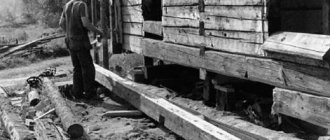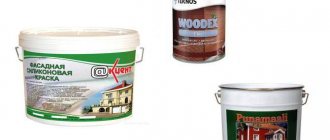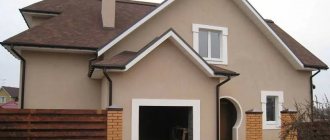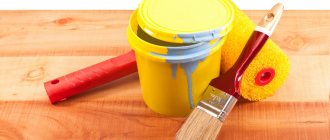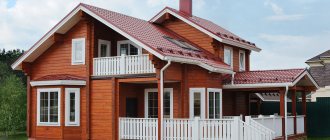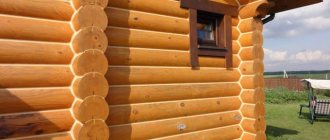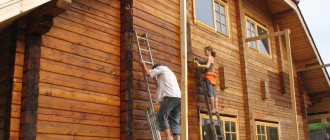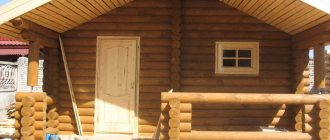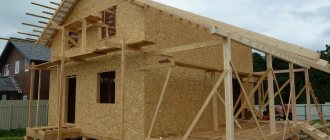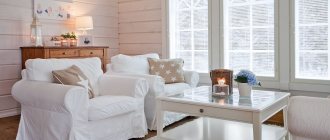Wooden houses and log baths are classics of country house construction. Such buildings look cozy and attractive, but under the inexorable influence of time and Mother Nature, the wood gradually begins to change. The original beauty of the facade fades, and the performance characteristics of the building deteriorate.
To preserve the facade and protect the house, the exterior of the log house is painted, for which the industry has developed a great variety of protective and decorative coatings. Sometimes the purpose of painting a log house is to even out the color (if the facade is faded on the sunny side), in which case the owners also strive to maintain the uniformity of the texture of the wooden surface. In any case, a guarantee of an excellent result will be the choice of a suitable composition and adherence to the technology for processing facade walls.
The facade of a country house takes on an attractive appearance Source peedilyearn.club
Choosing the right paint
Wood is a building material of natural origin and, unlike man-made brick and concrete, it reacts much more strongly to air humidity, wind, temperature fluctuations and solar radiation. Wood without bark can rot, burn out and become a haven for all kinds of molds and wood-boring beetles.
The factor that determines the service life and external decorative qualities of a log house is the choice of coating. Paints or impregnations for treating wooden façade walls are used to preserve wooden elements and must meet certain requirements:
- Create a surface protective layer that protects the wood from rain, snow and atmospheric moisture. Be frost-resistant (not destroyed by cyclical temperature changes).
- Have UV protection . Direct sunlight causes unprotected wood to change color (tanning effect) and lose its attractiveness.
- Have good adhesion (adhesion to the plane of the facade) and absorbency (important when processing with impregnation; penetration depth is indicated in the instructions for the product).
The type of paint is chosen based on its protective properties and visual appeal Source derevyannyy.com
- Demonstrate lack of moisture absorption .
- Be environmentally friendly . A parameter that is especially relevant for a log bathhouse.
- Don't lose your attractiveness. Varnish and acrylic compositions should not lose their original gloss. Paints must retain their original color .
- Contain fire retardant and antiseptic additives. Modern dyes are capable of maintaining the safety of a wooden structure.
- Be abrasion resistant .
The market offers a wide range of products suitable for painting the facade of timber and log houses. Modern coatings make it possible to preserve and emphasize the naturalness of the facade material or completely hide it under a protective layer. When deciding how to paint the exterior of a log house, owners give preference to proven, certified products. In practice, several types of coatings are used, the characteristics of which are useful to have an idea of.
The use of certified paints is a guarantee of high-quality painting Source fasad.guru
Antiseptic impregnations (waxes, stains) and varnishes
Liquid antiseptic impregnations for wooden surfaces penetrate the wood structure to a depth of 0.5-1 cm and create a barrier to all threats, natural and weather. There are two types of antiseptics on sale:
- Wax . Water-based wax is perfectly absorbed into wood, without creating a continuous film and maintaining its breathable properties. When finishing the exterior of a log house, a colorless or glazing (translucent) composition is used, creating a mother-of-pearl effect or an additional shade on the surface. Gives the facade water-repellent properties, leaving the natural structure visible.
- Wood stain . The composition is a tinting (impregnating) agent that colors the facade and protects it from biological contamination. The coating is short-lived, so a varnish is applied on top, which can extend the life of the stain and enhance its protective properties.
Treatment of wooden elements with fire retardant Source optimal-r.ru
- Varnishes (colorless or colored) are a proven, reliable means of protecting facades. Both options do not hide the natural texture of the wood; colored varnish can highlight its color. Varnishes, glazing impregnations and wax are used for painting not only outside, but also inside homes, where non-toxicity and external decorativeness are especially important.
Acrylic (acrylate) paints
Water-based acrylic paints for treating the external walls of a log house are considered the most acceptable, high-quality option with many advantages:
- contain solvents ;
- dry quickly and form a durable, vapor-permeable film;
- protect the wooden facade from ultraviolet radiation ;
- durable (resistant to weather vagaries);
- They retain their original color and shine for a long time (7-8 years) .
Impeccable appearance of acrylic paint Source materialyinfo.ru
See also: Catalog of companies that specialize in finishing materials.
The construction market offers several types of paints:
- Water-based acrylic paints . It is a water-acrylic emulsion (composition of two immiscible elements). After application to a wooden wall, the water evaporates, leaving a thin film layer with attractive properties on the surface. The paint does not have a strong odor, is flexible enough not to deteriorate under the influence of low temperatures, is vapor permeable (allows the wood to breathe) and at the same time waterproofs the facade.
- Water-based latex paints . They also contain acrylic resins, and therefore they are elastic, do not fade under solar ultraviolet radiation and are resistant to abrasion. Synthetic latex in the paint makes the surface silky in appearance. This paint is used when processing facades, window and door openings, and fences.
Types of decorative impregnation with water-based acrylates Source plantu.ru
- Alkyd compositions . They are produced on the basis of alkyd resins, which remain in the surface layer of wood to form a protective glossy layer. This paint fades quickly, but is resistant to negative temperatures and high humidity; it is often used to paint doors and window frames.
The disadvantage of acrylic dyes is their fairly high price. When painting log walls, they can be replaced with less expensive acrylate paints and aqualacs based on acrylate resins and dispersions, which reduce costs. These compositions have similar characteristics, they are safe and beautiful, but are designed for a shorter service life.
Oil based paint
Oil paint for a log house, used externally, is a familiar and fairly common method of painting. Despite its modest consumer qualities, it continues to be used; more often for painting fences than residential buildings.
Oil paint is a budget way to update a facade Source pkr.grunfest.ru
Recommendations for external finishing
Exterior finishing work can be done by yourself. This will allow you to reduce part of the budget when building a bathhouse. So, you will be able to control the processing process yourself and understand where you should apply more of the protective composition and where less.
Important! Before you start treating the outside of the bath, clean the wood from dust and dirt. First you need to wash the timber, and then give it time to dry.
You can also start sanding, and then apply protective substances to the wood in the following order - primer, antiseptic and fire retardant. Be sure to lubricate the cuts of the logs with lime or another substance of similar composition. This is necessary so that the vapors freely penetrate into the material lengthwise - this is better than if they penetrate across.
Also make sure there are no gaps when applying. To avoid missing a single centimeter, add color to the antiseptic. After everything is processed, leave the wood to dry.
Stages of preparing a log house for painting
In order for the paint layer to lay smoothly and beautifully, and for the coating of wooden walls to satisfy the quality throughout the guaranteed service life, it is necessary to consistently prepare the facade, adhering to the technology. Before the exterior of a wooden house is processed, a number of preparatory works are carried out:
- Grinding . It is mandatory even for new buildings (from 1 to 3 passes are performed). The surface is sanded using a power tool (grinder with coarse abrasive). This treatment removes defects left after sawing (or manual processing) - chips and minor cracks. Sanding also opens the pores of the wood, which facilitates deeper penetration of impregnation and paint.
- Polishing . It is carried out with a grinder with a fine-grained nozzle or sandpaper (which significantly delays the process). As a result of processing, a fresh, lighter layer of wood appears; the surface becomes even and smooth, absorbs paint better.
Sanding prepares the surface for painting Source gdeprosto.ru
Peculiarities
Caulking a bathhouse is a procedure carried out to minimize heat loss during the further operation of the structure. During the caulking process, the cracks, joints and gaps between the logs of the log house are filled with heat-insulating material (inter-crown insulation). As a result:
- the volume of heat loss during operation of the bath is reduced;
- the time for kindling and warming up the premises is reduced;
- fuel and electricity costs are reduced.
Caulking is a procedure that is carried out repeatedly throughout the construction of the bathhouse. This is due to the fact that the process of building a structure is accompanied by natural drying of the logs and gradual shrinkage of the log house, as a result of which new cracks may form in different parts of the bathhouse.
This procedure is carried out in two ways - stretching and dialing. In the first case, the insulation is placed in the cracks with fibers across, leaving an edge of the material 4-5 centimeters wide outside. Then this edge is rolled up with a roller, which is tucked into the cracks with a chisel.
In the second case, the insulation fibers are twisted into tight strands, which are pushed into the cracks between the logs using a chisel.
Painting the outside of a log house: stages of the process
Protective and decorative painting of a house made of rounded logs on the outside is the key to its long-term preservation without loss of visual appeal. Typically, processing is divided into several stages:
- Antiseptic . Impregnation of the facade with water- or oil-based antiseptics and fire retardants disinfects the wood and prevents new insects and microorganisms from appearing (1 to 2 passes are performed). It is convenient to apply the antiseptic through a spray bottle, so a respirator and safety glasses at this stage are not superfluous. Further procedures begin after the composition has completely dried.
- Primer . The purpose of the treatment is that the composition prepares the surface for final painting. The primer prevents tree resin from escaping (in knots) and staining the paint.
The paint color is chosen taking into account the style features Source gomabygg.com
- Adhesive primer (acrylic or oil, optional). The impregnating composition improves the adhesion of the base paint to the wooden wall and reduces paint consumption. Avoid getting dirt and dust on the drying primer.
- Cover paint . The main paint for a log house, the final layer that decorates and protects the walls. The ideal option is acrylic paint, applied in a thin layer sequentially in three steps, using a brush or roller.
How to apply antiseptic correctly
In principle, there is nothing complicated in this process. Here is the technology for doing it.
- A log house for a bathhouse made of timber must first be cleaned and sanded. This operation is based on the removal of bark particles and small wood defects. Particular attention will have to be paid to sanding; with its help, you can easily remove areas infected with mold and fungi.
- An antiseptic is applied. Choose the processing method yourself, as you find convenient. It is very important to carefully walk along the ends of the timber, at the places of its joints.
- After the applied layer has dried (each material has its own drying time, you need to read the instructions), the next one is applied. Typically, antiseptics are applied in three layers.
If a decision is made to carry out complex treatment, then the moment comes when a fire retardant composition can be applied. After it has dried, the bathhouse frame can be coated with a protective varnish.
Attention! Manufacturers' assurances that treatment can be carried out once every twenty to thirty years cannot be taken into account. Experts advise, and this is confirmed by practice, that log bathhouses must be treated with antiseptics once every five to seven years.
Painting the outside of a log house: factors affecting quality
The quality of painting a wooden country house depends mainly on two factors:
- Weather . Ideal weather is dry and windless. Do not paint in the sun (the paint will dry too quickly and unevenly), during or after rain. The permissible temperature is determined by the type of paint (indicated on the label).
- Wood moisture content . It should not exceed 20% during painting, so façade walls made of wood with natural humidity are painted after the frame has shrunk.
A necessary condition for a quality result is ease of use Source projecty-domov.ru
Means for processing the ends of logs
The domestic industry produces a special product for processing the ends of logs. It is recommended to choose from three manufacturers:
- Senezh Tor
- Neomid Thor Plus
- BIOTOR (Rogneda)
Means for processing the ends of logs Senezh Tor
Senezh Tor:
- Reduces the number and depth of shrinkage cracks
- Ensures preservation of the grade of valuable wood species
- Reduces linear deformation of timber during drying
- Prevents end moisture and wood rotting
- Does not contain chemical compounds prohibited in EU countries
- Slightly changes the color of the processed ends for ease of use
- An environmentally friendly product without solvents or odor
- Fire- and explosion-proof material
- Frost-resistant product
Means for processing the ends of logs Nemida Tor Plus
Provides protection to the ends of logs from rotting and damage by any fungi and pests:
- effectively protects wood from rotting
- prevents shrinkage cracking of wood
- reduces the degree of linear deformation
- creates a water-repellent barrier in wood fibers
- prevents the accumulation of excess moisture and end moisture
- forms an elastic thin-layer coating with high vapor permeability and water resistance, which allows the wood to “breathe”
- preserves the natural texture of wood
Product for processing the ends of logs BIOTOR
Forms an elastic film on the end, which eliminates the difference in the rate of moisture evaporation between the side and end surfaces, due to which the composition:
- prevents the formation and development of cracks;
- reduces the number and depth of shrinkage cracks;
- prevents the formation of linear deformations of timber during drying;
- provides protection of the ends from moisture and rotting.
Processing the ends of logs significantly reduces the percentage of longitudinal cracking of logs.
To provide a wooden house or bathhouse with good and durable protection, it is necessary to adhere to a certain order of work. Before treating the ends with an antiseptic, it is necessary to perform a number of mandatory operations.
The work is performed in the following sequence:
- Trimming of a log house. This operation involves cutting off the protruding parts of the logs. During the construction of a house from otsb, the size of the logs is not regulated. After construction, the length of the logs in the cuts is rarely the same, and the ends, as a rule, are also not perfectly even. The formation of a neat and even vertical plane is done after construction. The protruding ends are cut off with an electric or chainsaw.
- Next, the ends of the frame are polished. Using grinding, the surface is prepared for antiseptic treatment. After sanding, the absorbency of the wood increases, the ends will absorb the antiseptic better and more deeply, which will ultimately increase the period of action of the protective treatment.
At the first stage, rough surface treatment is performed using a grinder with coarse abrasive. Then the ends are sanded with a finer sanding attachment. Processing must be carried out until a layer of undamaged and clean wood appears.
- Protective treatment of ends with antiseptic. The ends are treated with a wide brush at least three times. Impregnation is applied in a generous layer. After the first layer has completely dried (about a day), apply the second, and then after 24 hours the third layer.
- Sealant treatment. This operation is performed after antiseptic treatment to create a durable moisture-repellent coating on the ends that prevents excessive moisture in the wood. For these purposes, it is recommended to use special acrylic sealants.
After the initial shrinkage of the log house, approximately 12 months after construction, the ends are painted with a product that creates a durable protective film on the surface. This can be either drying oil or paint containing oil or wax.
Antiseptic treatment is necessary in any case, even if in the future it is planned to finish the ends of the log house with siding, clapboard or other decorative building materials.
To discuss all working conditions in more detail, contact us using the coordinates in the “Contacts” section.
Calculate the cost of painting and insulating your home right now
Do you have accurate measurements of the house?
I measured it myself. I have a house design. Measurers came. I want to call a measurer.
By clicking on the button, you consent to the processing of personal data
Mistakes when painting a log house unqualified
If the desire to save on professional services for some reason outweighs the guarantee of the quality of the work performed, then after a while unsightly results such as stripes, stains and simply peeling areas on a recently painted surface are very likely. In such cases, the quality of the paint product is not always to blame. Unprofessional builders, due to inexperience, make basic mistakes that affect the final result:
- The facade is not properly prepared for painting: poor-quality sanding (or lack thereof) leaves the surface rough.
- painting technology (sequence) is violated
- Work is carried out in unsuitable conditions (high humidity or under the scorching sun).
- Newly erected ( naturally damp ) walls are painted.
- Incompatible materials were selected for painting .
Peeling of paint is caused by a violation of technology Source otdelka-expert.ru
Colored aqua oil for wood ADLER Lignovit Terra
from 1,248.00 rub.
Select options The advantage of colorless antiseptics is the preservation of the natural color of the wood. At the same time, it is recommended to work on such wood with a brush rather than a sprayer, since in this case it is easier to control the areas of the work done.
Painting an old wooden house
Over time, the painted facade begins to lose its attractive appearance - the paint peels off, mold appears, and the south side fades more rapidly. Sooner or later, the external walls of an old country house will require updating. Before repainting, the old coating is cleaned (for example, with a wire brush), and the surface is inspected to identify possible defects.
To ensure that the new layer goes on smoothly and lasts as long as it should, choose the same type of paint that was used originally. A study of the texture of the old coating will help determine what the façade was painted with:
- Acrylate paint . Thin, elastic structure reminiscent of leather; You can roll a piece of peeling paint into a roll.
- Oil paint . It has a matte color and may leave marks on your fingers after touching. You won’t be able to roll the roll—the fragment will crumble.
Old walls need careful preparation Source color-kostroma.ru
An old wooden house is painted in the same way as a new one. The difference is that it is not recommended to paint the old facade with a roller; it does not fill the unevenness that appears after periodic swelling and shrinkage of the fibers with paint. To give the old façade a neat look, painting the log house can be done in three or more layers.
Homemade recipes
There is a recipe for homemade wax impregnation, which includes beeswax and linseed oil, the ingredients are taken in equal proportions. The grated wax is melted in a water bath, and then it is mixed with the second component and allowed to cool.
It is recommended to use harmless protective materials to impregnate the walls of the steam room. The use of oils allows you to create a greasy film on the surface of a wooden structure and protect the wood itself from penetration deep into dirt. There is one minus here. For some time after contact with the treated surfaces, a greasy film will be felt, but soon the oil will be absorbed and partially erased, leaving only a protective film.
A good result is obtained after using melted natural wax. This impregnation is easy to do with your own hands. But the surface must first be thoroughly cleaned, degreased and only then wax applied.
Exterior painting of a log bathhouse
A bathhouse is a building with specific operating conditions; the interior of the log house is exposed to high humidity and temperature. Therefore, the main condition for the external coating is to maintain the vapor permeability of the walls. Otherwise, moisture will linger in the wood for a long time, creating a favorable environment for the development of mold microorganisms. When thinking about how to paint the exterior of a log bathhouse, do not forget about the nuances of processing the loghouse of a bathhouse:
- Logs must be dry and clean .
- In order for the protective layer of the new log house to serve as reliable protection, the lumber is treated with stain before collecting the crowns .
- Before repainting, the structure must be cool and ventilated .
Stages of processing and painting a bath Source do.59.ru
Impregnations are conveniently applied in the following sequence:
- Antiseptic . Products based on natural and synthetic oils are optimal.
- Fire retardant.
- Dye . The best option is acrylic facade paints, non-toxic, durable and vapor-permeable.
Conclusion
In the video presented in this article you will find additional information on this topic. Also, based on the text presented above, we can come to the conclusion that there are several effective means for external treatment of log walls (see also the article How to apply impregnation for a bathhouse). They have different degrees of protection and are used in accordance with the technical conditions and personal preferences of the master.
Did you like the article? Subscribe to our Yandex.Zen channel
The best manufacturers
It should be said that the market offers a wide selection of brands that produce impregnation.
In order not to get confused, study the list of the best manufacturers, including:
- Belinka – Slovenia. It has long earned the trust of customers.
- Neomid - Russia.
- Tikkurila - Finland.
- Pinotex – Estonia.
- Dufa - Germany.
- Veres - Serbia.
What you should pay attention to
Please note that the purchased bath impregnation may not always be well suited to certain surfaces, because of this you must know what little details you need to pay attention to and what criteria to use to make your choice.
It must be said that the choice of material should be based on what kind of surface you have and its chosen function.
Let's consider the basic criteria by which you can make a choice:
- Price - pay attention to this, since inexpensive options are most often not of good quality at all, but expensive ones often are. Therefore, to ensure that the impregnation is of high quality, choose a brand that is manufactured by one of the market leaders.
- Purpose is the most important criterion due to the fact that each material has its own function. Of course, it is allowed to apply any impregnation to a wooden surface, but its service life will be significantly reduced.
